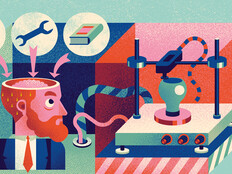ISTE 2013: The EV-olution of Lego Mindstorm Robotics
2013 marks the 15th year of Lego's commitment to robotics education. At the 2013 ISTE conference, attendees got a chance to see firsthand the Lego Mindstorms EV3, the company's third generation of the Lego Mindstorms system.
As a middle school robotics teacher who uses Lego Mindstorms every day, I was especially interested to see for myself how the new EV3 measures up to the current NXT version. There are improvements across the board: from the new software interface to a new and improved EV3 Intelligent Brick, which serves as the "brain" of the robot.
The shape of the EV3 Intelligent Brick is more square, which makes building with it more intuitive and also yields a more stable robot. In addition, pieces can be attached to it more quickly than before. The EV3 Intelligent Brick now has four input and four output ports (input ports are for attaching sensors, while output ports are for attaching actuators and motors). This gives users one additional output port than in the previous model. There is also a backlit display that clearly indicates the active state of the brick. Indicators glow green to show it's ready, yellow to indicate something may be wrong, and red to indicate there's a real problem. And athough "touch" is a popular user interface today, Lego decided to stick with its highly durable nontouch interface.
The EV3 Intelligent Brick also has a much higher onboard program storage capacity, including 16 megabytes of flash memory and 64MB of RAM. There's also a mini SDHC card reader for 32 gigabytes of expanded memory. To connect to the PC, users still have the option of USB and Bluetooth, but now they can also connect via a Wi-Fi dongle, sold separately. On-brick programming has been increased to 12 steps (up from 5 steps with the NXT brick), and those programs can be sent directly to the computer and will automatically populate in the software.
The sensor assortment includes an improved ultrasonic sensor that now has a listening mode and a visual indicator to tell the user whether it's listening or not. Lego also added a gyro sensor for measuring angles. Users get two touch sensors and an all-in-one color/light sensor. The kit includes two large servo motors and a medium-sized motor that's ideal for higher speed/lower torque applications. When attached, the sensors auto-identify inside the software, which makes wiring a lot easier.
New Classroom-Friendly Software Features
In the Lego Mindstorms Education EV3 software (PC and Mac compatible), the launch screen is called the Lobby. It serves as the main menu for all of the content provided by Lego as well as third parties. One really useful feature is the Content Editor. It allows teachers to add activities or customize and edit existing activities depending on a student's grade or competency level. Teachers can also create their own lessons and easily share them with their class. The Content Editor also gives students their own digital workbooks for sharing ideas among classmates.
Students can access all the tutorials from the Lobby and progress from basic step-by-step instructions to more complex projects. The program is still icon based, but the interface is completely redesigned. For example, instead of keeping the configuration panel for each block at the bottom of the screen while the block itself resides on some other part of the screen, now all the configuring is done more elegantly on the block itself in drop down menus.
Current NXT Mindstorms users may be wondering about backward compatibility from EV3 to the earlier NXT system. While NXT bricks can be programmed using the new Lego Mindstorms Education EV3 software, not all software features are supported by the NXT P-brick. And while all existing sensors, motors and building elements will work with the new platform, the NXT rechargeable battery cannot be used together with Lego Mindstorms EV3 Intelligent Brick.
Investing in Robotics Education
Lego intends to support the NXT platform with sets and software until the end of 2015, giving schools over two years to make the transition. For schools just beginning a robotics education program that haven't purchased any equipment, I'd recommend starting with the EV3 system; however, for schools that have already made a considerable investment in NXT systems and are just looking to add a few more kits to their existing program, it's probably best to scoop up a few NXT kits and take advantage of the drop in price as Lego begins to clear its shelves for EV3.
For a detailed chart comparing EV3 with NXT, visit Lego's website.








